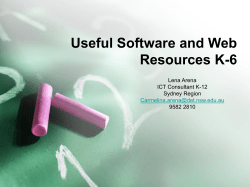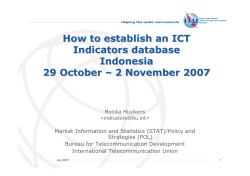
India : Information and Communication Technology for Growth & Development 2011
India : Information and Communication Technology for Growth & Development 2011 Shashank Ojha ICT SECTOR UNIT THE WORLD BANK NEW DELHI Contents 2 India - Country Background Current Status, Development Indicators, Goals and Strategies for growth and poverty reduction etc) ICT Industry in India Current status, Trends and indicators, Contribution to GDP, Employment in the Sector, Govt. Policies, Role of Private sector etc.) ICT for Development Human Development ( Education, Health, Social & Livelihood etc) Infrastructure ( Roads, Water, Power etc) Rural development & Agriculture Governance Challenges & Impediments Technology, Govt. Policy, Capacity Building, Change management, Business environment, Donor and Financing Suggestions for way-forward ICT Sector Unit - The World Bank India Country Background – Overview 3 With a population of just over 1.2 billion, India is the largest democracy in the world. In the past decade, the country has seen sustained high growth and has made progress on most of the Millennium Development Goals. India is in now the midst of a historic transformation. It has emerged as a global power and a leading player in information technology, telecoms and business outsourcing, with the world’s 4th largest economy in purchasing power parity terms. However, beneath India’s impressive growth is a tale of ‘two Indias’. While one India is on a rapid development trajectory, the other has 300 million people living below the poverty line. To address these disparities, the Government of India’s Eleventh Five Year Plan (2007-12) outlines a development agenda that targets significant investments for : generating employment, providing quality education and health for all, improving the welfare of women and children, developing infrastructure, and conserving the environment. Major investments are being made in into a set of very ambitious programs to deliver services to the poor. These programs -- to provide elementary education, basic health care, health insurance, rural employment, rural roads and rural connectivity, and other services -- aim at realizing the fundamental rights of the people. The programs are achieving partial results on the ground. Between 2003 and 2010, the no. of out-of-school children declined from 25 to 8 million (less than 5% of the 6-14 age group). Leprosy, polio, and TB are almost eradicated and the spread of AIDS has been kept in check. Large no. of women have been mobilized into self-help groups to generate new livelihood opportunities. Large investments are being made to improve the infrastructure Massive new initiatives are being pioneered that are revolutionizing the way services are being delivered to low-income groups. ICT Sector Unit - The World Bank India - Country Background 4 Key Development Indicators GROWTH: Population ( 2011) : 1.21 billion 50 % population below 25 years of age GDP Growth (2010- 11): 8.5% Poverty (Below National Poverty Line) : Rural: 28 % and Urban: 26 % Fertility rate: 2.5 births per woman Life expectancy at birth: 64 years 37% Infant mortality (per 1000 live births): 57 Maternal Mortality (per 100,000 live births):450 Children Underweight (below 5 years): 46% Primary school enrollment, net: 90% ; Male Adult literacy (age 15 and older): 73% and Female Adult literacy (age 15 and older): 48% Access to improved water source (% of pop): 89% Access to improved sanitation: 33% …………………………………………………………………………………… ICT Sector Unit - The World Bank ICT Industry in India 5 India’s ICT Sector is a global leader is IT Services and IT- enabled Services Exports Revenues : US $ 50.1 billion ( FY 2010) Exports contribution to total revenues - 70 % Service lines : 1. IT Services ( US $ 27. 3 billion) - application development, maintenance, testing, infrastructure services, consulting and systems integration etc. 2. BPO ( (US $ 12.4 billion) 3. Engineering Design and Product development ( US $ 10 billion) ICT Sector Unit - The World Bank ICT Industry in India 6 ICT Sector - key indicators Aggregate Revenues in FY 2010 : US $ 73.1 billion Direct Employment : 2.3 million Indirect additional employment : 8.2 million ( 30% employment for Age group 18-25 years; 4 % employment to economically backward classes, 60 % co.s employ differently-abled, 58 % employment from Tier II & III cities). Contribution to GDP in FY 2010-11 : 7 % ( In FY 98 - 1.2 %) Innovation ( FY 2005 -09) : 29 fold increase in patents Avg. R&D Spend : 1 % of Total Revenues ICT Sector Unit - The World Bank ICT Industry in India 7 India’s ICT Sector - VALUE PROPOSITION o o o o o o o o Strong fundamentals, a robust enabling environment and enhanced value delivery capability are the hallmarks Enjoys a cost advantage of around 60-70 per cent as compared to source markets. Timely Government policies have played a key role Govt.’s focus on education has helped create the large talent base from where the ICT industry draws its workforce. Government’s proactive approach towards the IT Sector through actions such as the IT Act Amendment, extension of tax incentives by a year, removal of the SEZ Act anomalies and the introduction of progressive telecom policies. Indian ICT Companies are now focusing trying to adopt a culture that encourages innovation, embrace new trends such as Green IT, and deliver solutions that are focused on Re-engineering and Transformation. India is emerging as a ‘Innovation Hub’ with increasing number of patents being filed /granted Economic downturn is the opportunity for the industry to enhance its overall efficiency - clients increasingly looking inwards and focusing on process benchmarking, enhanced utilization of infrastructure and talent, increasing productivity and greater customer engagement Source : NASSCOM ICT Sector Unit - The World Bank ICT Industry in India - Telecom 8 Telephones per 100 persons Telecom Sector Telecom Access 2011 ( May) (per 100 persons) Fixed line Mobile Internet users 34. 40 million 840 million 88 million Population covered by mobile - 73 % Total internet users - 6.9 % Fixed line tariff ($/pm) Mobile tariff ( $/pm) 3.5 1.6 ICT Sector Unit - The World Bank ICT Work Program- India 9 WB’s - India Program ( June 2011) Total No. of Projects Size of the portfolio : 81 : US $ 25.6 billion ICT - Key Activities ICT Support to Sector Projects e-Government Projects Telecom TA Projects ICT’s Participation : 21 Sector projects + NeGP Project ( FY 11) ICT Sector Unit - The World Bank ICT Work Program - India 10 Project Support Small Grants – Experimental / Pilots Medium – MIS Components in Sector Projects Large – eGovernment Projects ICT Sector Unit - The World Bank ICT for Development Projects 11 ICT for Development Projects Innovative ICT for Development Projects in India Mobile – based Innovative Solutions World Bank India - Projects E-Governance Projects ICT in Development Sectors ( Education, Health, Social & Livelihood, Rural development & Agriculture etc.) ICT Sector Unit - The World Bank Innovative Projects 12 ICT for Development - Innovative Projects e-Sewa Govt of AP ( Citizen e-Services) http://www.esevaonline.com Bhoomi - GoK ( Land Records) http://bhoomi.karnataka.gov.in MCA 21 ( Corporate affairs) http://www.mca.gov.in/MCA21/ ITC’s e-Choupal ( Agriculture Supply Chain) http://www.itcportal.com/rural-development/echoupal.htm Kerala’s Fisheries ( Mobile solutions for Fishermen) Lifelines ( Agriculture and Education Voice based Services) ICT Sector Unit - The World Bank Mobile –based Solutions 13 Mobile – based solutions o o o o Reuters Market Light ( Agr. Mkt Prices) SMS-One ( Community Newsletter - Local news, Local Advertisements etc.) Nokia Life Tools ( Agriculture Info, Education, Entertainment ) Ng Pay ( mobile based payments, shopping etc) ICT Sector Unit - The World Bank ICT India - Water Sector 14 Water Sector Projects UP- WSRP Rajasthan –WSRP Maharashtra- WSRP AP Water Sector ICT Sector Unit - The World Bank ICT India Projects - Water 15 Water / Irrigation Sector Solutions Application Framework Decision Support Systems & Knowledge Systems Water Resources Planning Data Collation, Analysis, Planning Water Resource Management Basin Database Network maintenance Maintenance planning Condition monitoring Real Time Distribution and Control Dams Database & Dams Safety GIS Database Enterprise Information / Decision Support Systems Procurement and Contracts Management Contracts and Contractors Management Tendering and Procurement HR Stakeholders Management Financial Projects Portal/Web Site for ID Human Resources Payroll Mgmt Assets Project Mgmt. AR AP Gen Ledger Planning / Budgeting Cash Management ID Intranet with Messaging, Groupware, Workflow ICT Sector Unit - The World Bank WUA/Farmers Info System Revenue Billing ICT India Projects - M&E 16 Monitoring & Evaluation Systems Water & Sanitation Project Two major ICT Initiatives under the Project : • Computerization of the Fund Board • Creating and automating the M&E Framework for the entire water sector in the country. ICT Sector Unit - The World Bank ICT India Projects - Transport 17 Assam PWD Computerisation Project (APCP) Transport Sector · Business Process Reengineering of Financial, HR, etc. modules developed by GOA · · · Project Life Cycle & Cost-Benefit & Analysis module · · · · · · · · · PWD. Building the system software by customizing packaged application OTS. Networking 20 sites with hub at C.E’s office. Developing master database and incorporation of historical data. Project preparation system Project management Document Management System Intensive training. Vendor management & payment system. Quality control system. Stores & inventory management Employee Information system Interfaces with engineering intensive modules. Assam Roads Project specific modules like OMMS (PMGSY) TN Roads Kerala Roads Punjab Roads HP Roads National Highways Disaster Management System (DMS) ICT Sector Unit - The World Bank Authority of India Assam PWD Computerization Project 18 ICT Solution Framework - Road ICT Sector Unit - The World Bank Projects ICT India Projects - Health 19 Health Mgt. Systems Core Modules Health Sector Projects IDSP Food & Drug Control Source : Rajasthan Health Project ICT Sector Unit - The World Bank Capacity ( Closed) Malaria Control ( Closed) AIDS (Closed) Karnataka State Health Project Tamil Nadu State Health Project Rajasthan Health Project ICT India Projects - Education 20 Education Projects o Pilot ICT Project in Rural Pune o e-Class & Teacher- Student Portal for Govt. of Uttarakhand o Bihar TEMIS o Vocational Education o Technical Education II ICT Sector Unit - The World Bank ICT in Education 21 ICT Pilot Project in Rural Districts of Pune Mobile Computer Van 53 schools in about 40 villages scattered around Baramati Computer Education for approx 6300 students of Classes 5-6-7 5 Mobile Computer Vans with 18 computers on each van ICT Sector Unit - The World Bank ICT India – Agriculture & RD 22 Agr. & Rural Devp. Projects Sodic Lands Project (Closed) UP Forestry (Closed) ICT in Rural Districts of Pune (Closed) National Agriculture Innovation Project Source : AGROPEDIA , NAIP Project ICT Sector Unit - The World Bank ICT India Projects – Rural Development ICT Pilot Project in Rural Pune Micro Finance Cooperatives 23 Poultry Cooperatives Milk Cooperatives ICT Sector Unit - The World Bank ICT India – e-Governance 24 EIMS UMS MMIS Education CMS APNET SMS Data Centre VASTIS Revenue Excise FAST PKI eCOPS e-Health HRMS IFIS Healthcare DIMS CARD ICPS e-Seva HIMS MAS Civic PRISM Services CGRS Telemed smartcard FACTS Police e-Proc eACB CCMS Core Applications OLTP Portal SBMS GIS Welfare Payment Gateway Datawarehouse WCMS JUDIS SmartGov Kiosks Judiciary e-Government Blueprint .. an ‘inside out’ view FIS AGRIS AnSys Agriculture PAX CopSys MarkNet LIFE InSys Business eCRM e.Biz @pfirst PMS Engineering APIIS AP Govt.’s e-Government Project Framework ICT Sector Unit - The World Bank ICT India Projects e-Governance 25 India – National E- Governance Action Plan NeGP CENTRAL (7) STATE-LEVEL (9) INTEGRATED (9) Income tax Central Excise Passport, visa & immigration MCA 21 Agriculture Comprehensive Modernization of Land Records Transport Treasuries Unique ID Pensions Industry Initiative: Banking Insurance Commercial Taxes Panchayati Raj Institutions Municipalities Police Employment Exchange Public Distribution System (PDS) – State-defined. e-Biz EDI India Portal Common Service Centers (CSCs) e-Gateway e-Courts e-Office e-Government Procurement e-Districts PROGRAM COMPONENTS (8) Core Technology Policies and Standards Core Infrastructure: State Wide Area Networks (SWANs) State Data Centers (SDCs) Technical Assistance HRD & Training Awareness & Assessment Program Management Structures R&D NeGP Mission Mode Projects & Program Components ICT Sector Unit - The World Bank ICT India Projects – NeGP 26 E-Delivery of Public Services Development Policy Loan Pillar I. Higher emphasis on coordination 1.1 Strengthening state institutions in e-Governance. 1.2 Development of technical standards for e-Governance 1.3 Improved inter-agency coordination and monitoring of e-governance. Pillar II. Increased reach out to the “common man.” 2.1 Improving access to services by using the mobile platform while increasing the pace of internet penetration 2.2 Facilitating increased participation of citizens in design and evaluation of e-governance projects. 2.3 Improving service orientation of Govt. Processes and officials. 2.4 E-Services Delivery Act (ESD Act) 2.5 Uniform and predictable verification of e-Service users. ICT Sector Unit - The World Bank ICT India Projects - Governance 27 e-HR Project (Govt. of Karnataka) Computerized Human Resource Function of GoK to support : ICT Sector Unit - The World Bank Civil Service Restructuring Promote Human Resources Development - career counseling Facilitate Functional Reviews Lead to right-sizing of the workforce, if necessary Management of Pensions Provide information for decision making (day-today as well as forward planning) Pilot Implementation Successfully completed. Scale up in progress through government funds. ICT India Projects - e-Government 28 Govt. of Uttarakhand – eGovernment Pilots . • Establishment of IT Devp. Authority. • • • • Agriculture Portal Tourism Portal Project. Social Welfare DBMS Project. Citizen Data Vault Project / • Multipurpose Household survey • Citizen Data Vault. • Smart Card for Public Distribution • • • • • ICT Sector Unit - The World Bank HRMS Project Urban Development Project Public Works Department Project. Teacher Student Portal e-Class Content Development ICT India Projects - Urban Devp. 29 Tamil Nadu Urban Development Project II System s ByProjectOwn Total CollectionFacilities W ithinOffice W ithinULB Bank ULBs Urban Devp Project II & III Tamilnadu Municipalities Corporation TownPanchayats Aggregate 102 5 611 718 Coimbatore ICT Sector Unit - The World Bank 718 202 655 1575 374 116 0 490 1092 318 655 2065 85 25 0 110 14 34 0 48 Total 7 34 0 41 106 93 0 199 ICT India Projects - Urban 30 Tamil Nadu Urban Development Project II Services 1. Others Birth and Death registration Building Plan Registration/ Approval 3. Dangerous and Offensive & PFA Financial Management 1. Financial Accounting System 2. Inventory Control 3. Movable Property 4. Vehicle Inventory 5. Immovable Property Revenue Management 1. Non-Tax 2. Professional Tax 3. Water Charges 4. Property Tax 1. Census 2. 3. Personal Management System Electoral rolls 4. Family Enumeration 5. Solid Waste management 6. Hospital Information 2. ICT Sector Unit - The World Bank ICT India Projects - Urban 31 Tamilnadu UDP II - impact Increasing Demand from staff and citizens - (ULB’s on their own have invested in 1575 PCs from the project, additional 490 by ULBs) A 10-15% improvement in collections have been recorded as against manual systems. (Roughly an increase in revenue of about US $ 7-8 million). An issue especially in terms of closure of subsidiary revenue registers has been of collection greater than demand… (about 10 % of errors in demand registers rectified - $ 2 million ) Birth and death certificates issued in 15 minutes (2-7 days). The impact, closure of accounting books by 5.30-6 PM as against months before automation. ICT Sector Unit - The World Bank Main Challenges 32 Challenges & Impediments ICT Sector strengthens have had limited impact on ICT for Development ICT has not yet been mainstreamed as tool for growth, efficiency and development Large disparities in State and department capabilities Inadequate Policy and Legislative push Support infrastructure remains a major challenge Power Connectivity Literacy and Language Funding and financing strategy ICT Sector Unit - The World Bank Main Challenges 33 High Risk – High Returns projects ! Limited Human Resources in e-Governance 100+ Pilots in states not scaled –up Implementation approach / lack of BPR / inadequate policy support Lack of HR and tech capacity – no cadre Very complex projects / require continuous upgrade and monitoring Inadequate awareness / lack of capacity in policy & decision makers Project Management -Difficulties abound Delayed, limited functionality, budget over-runs Financial Sustainability - Rarely achieved ? Grassroots consultation Top down approach rarely works ! IT Policy & Law ICT Sector Unit - The World Bank Main Challenges continued . . . 34 Standardization / Policy Framework Standalone efforts, Islands ! Sector level Solutions ! Local language / Locally relevant content English content, illiteracy, target audience ? Reinventing the Wheel ! Duplicate efforts - wasted cost, time and funds Wiring India – last mile solutions Need for low cost connectivity ? ICT Sector Unit - The World Bank Suggestions 35 Suggestions for way-forward Promote Policy for Investment in ICTs Capacity Building & HR – especially at state level Development for Core Solutions Targeted ICT Initiatives for social and financial inclusion Mainstreaming Mobile based solutions Support for Project Development & Pilots Improved Research and Analytical underpinning for impact measurement PPP Approach & Financing Models ICT Sector Unit - The World Bank Thank you. Shashank Ojha ICT SECTOR UNIT THE WORLD BANK NEW DELHI sojha@worldbank.org
© Copyright 2025









